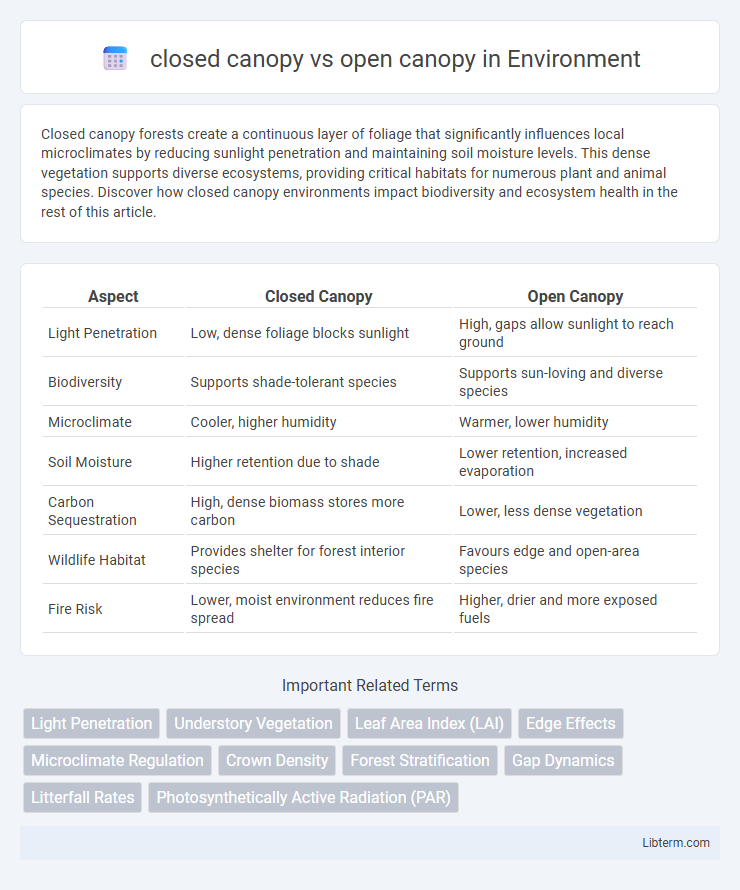Closed canopy forests create a continuous layer of foliage that significantly influences local microclimates by reducing sunlight penetration and maintaining soil moisture levels. This dense vegetation supports diverse ecosystems, providing critical habitats for numerous plant and animal species. Discover how closed canopy environments impact biodiversity and ecosystem health in the rest of this article.
Table of Comparison
| Aspect | Closed Canopy | Open Canopy |
|---|---|---|
| Light Penetration | Low, dense foliage blocks sunlight | High, gaps allow sunlight to reach ground |
| Biodiversity | Supports shade-tolerant species | Supports sun-loving and diverse species |
| Microclimate | Cooler, higher humidity | Warmer, lower humidity |
| Soil Moisture | Higher retention due to shade | Lower retention, increased evaporation |
| Carbon Sequestration | High, dense biomass stores more carbon | Lower, less dense vegetation |
| Wildlife Habitat | Provides shelter for forest interior species | Favours edge and open-area species |
| Fire Risk | Lower, moist environment reduces fire spread | Higher, drier and more exposed fuels |
Introduction to Canopy Types
Closed canopy forests are characterized by densely packed tree crowns that overlap, creating continuous shade and a stable microclimate beneath. Open canopy forests feature widely spaced trees with gaps that allow more sunlight to reach the forest floor, promoting diverse undergrowth and varying habitats. Understanding these canopy structures is essential for ecological studies, biodiversity assessments, and forest management practices.
Defining Closed Canopy Ecosystems
Closed canopy ecosystems feature dense tree coverage where the foliage of adjacent trees overlaps, creating a continuous layer that limits sunlight penetration to the forest floor. These environments foster high humidity and stable microclimates, supporting diverse understory vegetation and specialized wildlife. Characterized by minimal gaps in the canopy, closed canopy forests play a crucial role in carbon sequestration and maintaining ecological balance.
Features of Open Canopy Habitats
Open canopy habitats feature widely spaced trees allowing abundant sunlight to reach the ground, promoting diverse understory vegetation growth. These environments support varied wildlife by offering increased visibility and access to resources such as food and shelter. The structural heterogeneity in open canopies often leads to higher biodiversity compared to closed canopy systems.
Biodiversity in Closed vs. Open Canopies
Closed canopies support higher biodiversity by providing stable microclimates and diverse niches for various flora and fauna, enhancing species richness and ecosystem complexity. Open canopies allow increased sunlight penetration, promoting different plant communities and specialized species adapted to these conditions, but often result in lower overall biodiversity compared to closed forests. The structural differences in canopy coverage directly influence habitat diversity, affecting wildlife density and plant species composition in forest ecosystems.
Light Availability and Photosynthesis
Closed canopy forests create a dense layer of foliage that significantly reduces light availability on the forest floor, limiting photosynthesis to shade-tolerant plant species. Open canopy environments allow greater penetration of sunlight, enhancing light availability and promoting higher photosynthetic rates in understory vegetation. Variations in light intensity directly influence the photosynthetic capacity and growth patterns of plants within these distinct canopy structures.
Impacts on Soil and Microclimate
Closed canopy forests maintain higher soil moisture and cooler temperatures by reducing sunlight penetration, which limits evaporation and sustains microbial activity critical for nutrient cycling. Open canopy areas experience increased soil temperature and reduced moisture, leading to accelerated organic matter decomposition but greater vulnerability to erosion and nutrient loss. These contrasting microclimatic conditions significantly influence soil fertility, plant growth, and ecosystem resilience.
Fauna Adaptations to Canopy Structure
Fauna adaptations to closed canopy environments include enhanced camouflage and reduced light sensitivity due to dense foliage and limited sunlight penetration. In contrast, species inhabiting open canopies exhibit traits such as increased mobility and heightened visual acuity to navigate well-lit, exposed habitats. These structural differences significantly influence behavioral patterns, predator-prey dynamics, and resource utilization among forest-dwelling animals.
Effects of Human Activity on Canopy Patterns
Human activity significantly alters canopy patterns, with deforestation and urban development often converting closed canopies into open canopies, leading to loss of biodiversity and changes in microclimates. Open canopies resulting from logging or land clearing increase sunlight penetration, affecting understorey vegetation and soil moisture levels, which can disrupt native habitats. Conversely, closed canopies maintained by minimal human disturbance support stable ecosystems by regulating temperature and preserving moisture, crucial for diverse flora and fauna.
Conservation Challenges in Different Canopies
Closed canopy forests present conservation challenges due to limited light penetration, which affects understory biodiversity and complicates habitat restoration efforts. Open canopy areas face increased vulnerability to invasive species and soil erosion because of greater exposure to sunlight and wind. Both canopy types require tailored management strategies to balance ecosystem stability and species conservation.
Future Trends in Canopy Management
Future trends in canopy management emphasize precision agriculture techniques that leverage drone imagery and AI-driven analytics to optimize leaf density in both closed and open canopies. Closed canopy systems are increasingly targeted for maximizing light interception and microclimate control to enhance photosynthesis and fruit quality. Open canopy designs are being refined through advanced pruning strategies to improve airflow, reduce disease risk, and facilitate mechanized harvesting, aligning with sustainability and labor-saving goals.
closed canopy Infographic

 libterm.com
libterm.com